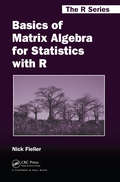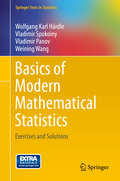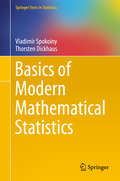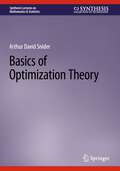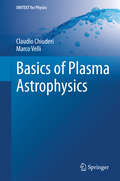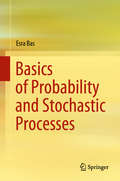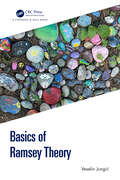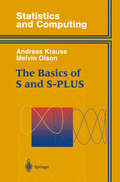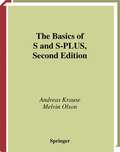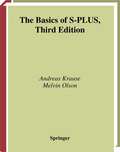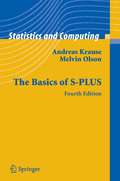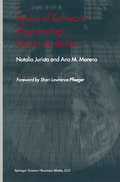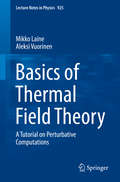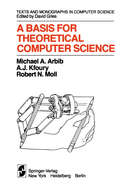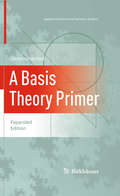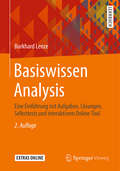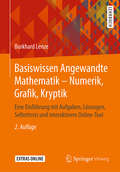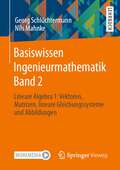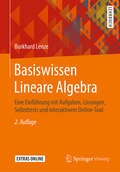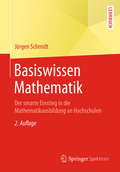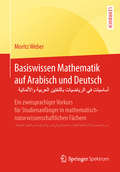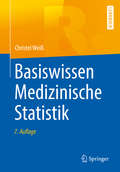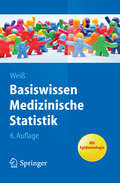- Table View
- List View
Basics of Matrix Algebra for Statistics with R (Chapman & Hall/CRC The R Series)
by Nick FiellerA Thorough Guide to Elementary Matrix Algebra and Implementation in R Basics of Matrix Algebra for Statistics with R provides a guide to elementary matrix algebra sufficient for undertaking specialized courses, such as multivariate data analysis and linear models. It also covers advanced topics, such as generalized inverses of singular and rectangular matrices and manipulation of partitioned matrices, for those who want to delve deeper into the subject. The book introduces the definition of a matrix and the basic rules of addition, subtraction, multiplication, and inversion. Later topics include determinants, calculation of eigenvectors and eigenvalues, and differentiation of linear and quadratic forms with respect to vectors. The text explores how these concepts arise in statistical techniques, including principal component analysis, canonical correlation analysis, and linear modeling. In addition to the algebraic manipulation of matrices, the book presents numerical examples that illustrate how to perform calculations by hand and using R. Many theoretical and numerical exercises of varying levels of difficulty aid readers in assessing their knowledge of the material. Outline solutions at the back of the book enable readers to verify the techniques required and obtain numerical answers. Avoiding vector spaces and other advanced mathematics, this book shows how to manipulate matrices and perform numerical calculations in R. It prepares readers for higher-level and specialized studies in statistics.
Basics of Matrix Algebra for Statistics with R (Chapman & Hall/CRC The R Series #31)
by Nick FiellerA Thorough Guide to Elementary Matrix Algebra and Implementation in R Basics of Matrix Algebra for Statistics with R provides a guide to elementary matrix algebra sufficient for undertaking specialized courses, such as multivariate data analysis and linear models. It also covers advanced topics, such as generalized inverses of singular and rectangular matrices and manipulation of partitioned matrices, for those who want to delve deeper into the subject. The book introduces the definition of a matrix and the basic rules of addition, subtraction, multiplication, and inversion. Later topics include determinants, calculation of eigenvectors and eigenvalues, and differentiation of linear and quadratic forms with respect to vectors. The text explores how these concepts arise in statistical techniques, including principal component analysis, canonical correlation analysis, and linear modeling. In addition to the algebraic manipulation of matrices, the book presents numerical examples that illustrate how to perform calculations by hand and using R. Many theoretical and numerical exercises of varying levels of difficulty aid readers in assessing their knowledge of the material. Outline solutions at the back of the book enable readers to verify the techniques required and obtain numerical answers. Avoiding vector spaces and other advanced mathematics, this book shows how to manipulate matrices and perform numerical calculations in R. It prepares readers for higher-level and specialized studies in statistics.
Basics of Modern Mathematical Statistics: Exercises and Solutions (Springer Texts in Statistics)
by Wolfgang Karl Härdle Vladimir Spokoiny Vladimir Panov Weining WangThe complexity of today’s statistical data calls for modern mathematical tools. Many fields of science make use of mathematical statistics and require continuous updating on statistical technologies. Practice makes perfect, since mastering the tools makes them applicable. Our book of exercises and solutions offers a wide range of applications and numerical solutions based on R.In modern mathematical statistics, the purpose is to provide statistics students with a number of basic exercises and also an understanding of how the theory can be applied to real-world problems.The application aspect is also quite important, as most previous exercise books are mostly on theoretical derivations. Also we add some problems from topics often encountered in recent research papers.The book was written for statistics students with one or two years of coursework in mathematical statistics and probability, professors who hold courses in mathematical statistics, and researchers in other fields who would like to do some exercises on math statistics.
Basics of Modern Mathematical Statistics: Exercises And Solutions (Springer Texts in Statistics)
by Vladimir Spokoiny Thorsten DickhausThis textbook provides a unified and self-contained presentation of the main approaches to and ideas of mathematical statistics. It collects the basic mathematical ideas and tools needed as a basis for more serious study or even independent research in statistics. The majority of existing textbooks in mathematical statistics follow the classical asymptotic framework. Yet, as modern statistics has changed rapidly in recent years, new methods and approaches have appeared. The emphasis is on finite sample behavior, large parameter dimensions, and model misspecifications. The present book provides a fully self-contained introduction to the world of modern mathematical statistics, collecting the basic knowledge, concepts and findings needed for doing further research in the modern theoretical and applied statistics. This textbook is primarily intended for graduate and postdoc students and young researchers who are interested in modern statistical methods.
Basics of Optimization Theory (Synthesis Lectures on Mathematics & Statistics)
by Arthur David SniderThis book presents a short introduction to the main tools of optimization methodology including linear programming, steepest descent, conjugate gradients, and the Karush-Kuhn-Tucker-John conditions. Each topic is developed in terms of a specific physical model, so that the strategy behind every step is motivated by a logical, concrete, easily visualized objective. A quick perusal of the Fibonacci search algorithm provides a simple and tantalizing first encounter with optimization theory, and a review of the max-min exposition of one-dimensional calculus prepares readers for the more sophisticated topics found later in the book. Notable features are the innovative perspectives on the simplex algorithm and Karush-Kuhn-Tucker-John conditions as well as a wealth of helpful diagrams. The author provides pointers to references for readers who would like to learn more about rigorous definitions, proofs, elegant reformulations and extensions, and case studies. However, the book is sufficiently self-contained to serve as a reliable resource for readers who wish to exploit commercially available optimization software without investing the time to develop expertise in its aspects.This book also:Features innovative perspectives on the simplex algorithm and Krushal-Kuhn-Tucker-John conditionsServes as a resource for readers to use the tools of optimization without needing to acquire expertise in the theoryFeatures plentiful resources that focus on rigorous definitions, proofs, and case studies
Basics of Plasma Astrophysics (UNITEXT for Physics)
by Claudio Chiuderi Marco VelliThis book is an introduction to contemporary plasma physics that discusses the most relevant recent advances in the field and covers a careful choice of applications to various branches of astrophysics and space science. The purpose of the book is to allow the student to master the basic concepts of plasma physics and to bring him or her up to date in a number of relevant areas of current research. Topics covered include orbit theory, kinetic theory, fluid models, magnetohydrodynamics, MHD turbulence, instabilities, discontinuities, and magnetic reconnection. Some prior knowledge of classical physics is required, in particular fluid mechanics, statistical physics, and electrodynamics. The mathematical developments are self-contained and explicitly detailed in the text. A number of exercises are provided at the end of each chapter, together with suggestions and solutions.
Basics of Probability and Stochastic Processes
by Esra BasThis textbook explores probability and stochastic processes at a level that does not require any prior knowledge except basic calculus. It presents the fundamental concepts in a step-by-step manner, and offers remarks and warnings for deeper insights. The chapters include basic examples, which are revisited as the new concepts are introduced. To aid learning, figures and diagrams are used to help readers grasp the concepts, and the solutions to the exercises and problems. Further, a table format is also used where relevant for better comparison of the ideas and formulae. The first part of the book introduces readers to the essentials of probability, including combinatorial analysis, conditional probability, and discrete and continuous random variable. The second part then covers fundamental stochastic processes, including point, counting, renewal and regenerative processes, the Poisson process, Markov chains, queuing models and reliability theory. Primarily intended for undergraduate engineering students, it is also useful for graduate-level students wanting to refresh their knowledge of the basics of probability and stochastic processes.
Basics of Ramsey Theory
by Veselin JungićBasics of Ramsey Theory serves as a gentle introduction to Ramsey theory for students interested in becoming familiar with a dynamic segment of contemporary mathematics that combines ideas from number theory and combinatorics. The core of the of the book consists of discussions and proofs of the results now universally known as Ramsey’s theorem, van der Waerden’s theorem, Schur’s theorem, Rado’s theorem, the Hales–Jewett theorem, and the Happy End Problem of Erdős and Szekeres. The aim is to present these in a manner that will be challenging but enjoyable, and broadly accessible to anyone with a genuine interest in mathematics. Features Suitable for any undergraduate student who has successfully completed the standard calculus sequence of courses and a standard first (or second) year linear algebra course. Filled with visual proofs of fundamental theorems. Contains numerous exercises (with their solutions) accessible to undergraduate students. Serves as both a textbook or as a supplementary text in an elective course in combinatorics and aimed at a diverse group of students interested in mathematics.
Basics of Ramsey Theory
by Veselin JungićBasics of Ramsey Theory serves as a gentle introduction to Ramsey theory for students interested in becoming familiar with a dynamic segment of contemporary mathematics that combines ideas from number theory and combinatorics. The core of the of the book consists of discussions and proofs of the results now universally known as Ramsey’s theorem, van der Waerden’s theorem, Schur’s theorem, Rado’s theorem, the Hales–Jewett theorem, and the Happy End Problem of Erdős and Szekeres. The aim is to present these in a manner that will be challenging but enjoyable, and broadly accessible to anyone with a genuine interest in mathematics. Features Suitable for any undergraduate student who has successfully completed the standard calculus sequence of courses and a standard first (or second) year linear algebra course. Filled with visual proofs of fundamental theorems. Contains numerous exercises (with their solutions) accessible to undergraduate students. Serves as both a textbook or as a supplementary text in an elective course in combinatorics and aimed at a diverse group of students interested in mathematics.
The Basics of S and S-PLUS (Statistics and Computing)
by Andreas Krause Melvin OlsonThe basics of S-PLUS written in a clear style at a level suitable for people with little computing or statistical knowledge. Unlike the S-PLUS manuals, this is not comprehensive, but instead introduces the most important ideas of S-PLUS by way of many examples. Each chapter also includes a collection of exercises which are accompanied by fully worked-out solutions and detailed comments. The whole is rounded off with practical hints on how efficient work can be performed in S-PLUS, and is thus well-suited for self-study and as a textbook.
The Basics of S and S-PLUS (Statistics and Computing)
by Andreas Krause Melvin OlsonA lucid explanation of the basics of S-PLUS at a level suitable for users with little computing or statistical knowledge. Unlike the S-PLUS manuals, the book does not strive to be comprehensive, but instead introduces the most important ideas of S-PLUS through the use of many examples. Each chapter includes a collection of exercises that are accompanied by fully worked-out solutions and detailed comments, and the whole is rounded off with practical hints on how to work efficiently in S-PLUS, making it well-suited for both self-study and as a textbook. This second edition has been updated to incorporate the completely revised S Language and its implementation in S-PLUS, while new chapters have been added to explain the Windows GUI, how to explore relationships in data using the powerful Trellis graphics system, and how to understand and use object-oriented programming. In addition, the programming chapter has been extended to cover some of the more technical but important aspects of S-PLUS.
The Basics of S-PLUS (Statistics and Computing)
by Andreas Krause Melvin OlsonIn a clear style the most important ideas of S-PLUS are introduced through the use of many examples. Each chapter includes a collection of exercises, fully worked-out solutions and detailed comments.
The Basics of S-PLUS (Statistics and Computing)
by Andreas Krause Melvin OlsonProven bestseller: almost 6000 copies sold in the U.S. in two editions New edition updated to cover S-PLUS 6.0 Can be used as an introduction to R, as well as S-PLUS New exercises have been added; Includes a comparison of S-PLUS and R Well-suited for self-study
Basics of Software Engineering Experimentation
by Natalia Juristo Ana M. MorenoBasics of Software Engineering Experimentation is a practical guide to experimentation in a field which has long been underpinned by suppositions, assumptions, speculations and beliefs. It demonstrates to software engineers how Experimental Design and Analysis can be used to validate their beliefs and ideas. The book does not assume its readers have an in-depth knowledge of mathematics, specifying the conceptual essence of the techniques to use in the design and analysis of experiments and keeping the mathematical calculations clear and simple. Basics of Software Engineering Experimentation is practically oriented and is specially written for software engineers, all the examples being based on real and fictitious software engineering experiments.
Basics of Thermal Field Theory: A Tutorial on Perturbative Computations (Lecture Notes in Physics #925)
by Mikko Laine Aleksi VuorinenThis book presents thermal field theory techniques, which can be applied in both cosmology and the theoretical description of the QCD plasma generated in heavy-ion collision experiments. It focuses on gauge interactions (whether weak or strong), which are essential in both contexts. As well as the many differences in the physics questions posed and in the microscopic forces playing a central role, the authors also explain the similarities and the techniques, such as the resummations, that are needed for developing a formally consistent perturbative expansion. The formalism is developed step by step, starting from quantum mechanics; introducing scalar, fermionic and gauge fields; describing the issues of infrared divergences; resummations and effective field theories; and incorporating systems with finite chemical potentials. With this machinery in place, the important class of real-time (dynamic) observables is treated in some detail. This is followed by an overview of a number of applications, ranging from the study of phase transitions and particle production rate computations, to the concept of transport and damping coefficients that play a ubiquitous role in current developments. The book serves as a self-contained textbook on relativistic thermal field theory for undergraduate and graduate students of theoretical high-energy physics.
A Basis for Theoretical Computer Science (Monographs in Computer Science)
by M.A. Arbib A.J. Kfoury R.N. MollComputer science seeks to provide a scientific basis for the study of inform a tion processing, the solution of problems by algorithms, and the design and programming of computers. The last forty years have seen increasing sophistication in the science, in the microelectronics which has made machines of staggering complexity economically feasible, in the advances in programming methodology which allow immense programs to be designed with increasing speed and reduced error, and in the development of mathematical techniques to allow the rigorous specification of program, process, and machine. The present volume is one of a series, The AKM Series in Theoretical Computer Science, designed to make key mathe matical developments in computer science readily accessible to under graduate and beginning graduate students. Specifically, this volume takes readers with little or no mathematical background beyond high school algebra, and gives them a taste of a number of topics in theoretical computer science while laying the mathematical foundation for the later, more detailed, study of such topics as formal language theory, computability theory, programming language semantics, and the study of program verification and correctness. Chapter 1 introduces the basic concepts of set theory, with special emphasis on functions and relations, using a simple algorithm to provide motivation. Chapter 2 presents the notion of inductive proof and gives the reader a good grasp on one of the most important notions of computer science: the recursive definition of functions and data structures.
A Basis Theory Primer: Expanded Edition (Applied and Numerical Harmonic Analysis)
by Christopher HeilThis textbook is a self-contained introduction to the abstract theory of bases and redundant frame expansions and their use in both applied and classical harmonic analysis. The four parts of the text take the reader from classical functional analysis and basis theory to modern time-frequency and wavelet theory. Extensive exercises complement the text and provide opportunities for learning-by-doing, making the text suitable for graduate-level courses. The self-contained presentation with clear proofs is accessible to graduate students, pure and applied mathematicians, and engineers interested in the mathematical underpinnings of applications.
Basiswissen Analysis: Eine Einführung mit Aufgaben, Lösungen, Selbsttests und interaktivem Online-Tool
by Burkhard LenzeDieses Buch bietet eine schlanke und gut zugängliche Hinführung zur Analysis. Gut 100 komplett durchgerechnete Beispiele, etwa 50 Aufgaben mit Lösungen sowie rund 40 kleine Selbsttests mit Antworten erleichtern den Zugang zum Thema. Abgerundet wird das Ganze durch etwa 80 Skizzen im Text sowie ein online verfügbares interaktives pdf-Tool zum Generieren von Zufallsaufgaben inklusive Lösungen. Das Buch richtet sich an Studierende in Studiengängen mit mathematischen Pflichtveranstaltungen im Grundstudium an Universitäten und Fachhochschulen. Es ist sowohl als Begleitlektüre für entsprechende Vorlesungen als auch zum Selbststudium optimal geeignet.
Basiswissen Angewandte Mathematik – Numerik, Grafik, Kryptik: Eine Einführung mit Aufgaben, Lösungen, Selbsttests und interaktivem Online-Tool
by Burkhard LenzeDieses Buch bietet eine schlanke und gut zugängliche Hinführung zur Angewandten Mathematik, speziell zur Numerischen Mathematik, Aspekten der Computer-Grafik sowie der Verschlüsselungstechnik. Rund 140 komplett durchgerechnete Beispiele, gut 100 Aufgaben mit Lösungen sowie etwa 50 Selbsttests mit Lösungen erleichtern den Zugang zum Thema. Abgerundet wird das Ganze durch etwa 80 Skizzen im Text sowie ein online verfügbares interaktives pdf-Tool zum Generieren von Zufallsaufgaben inklusive Lösungen. Das Buch richtet sich an Studierende in Studiengängen mit mathematischen Pflichtveranstaltungen im Grundstudium an Universitäten und Fachhochschulen. Es ist sowohl als Begleitlektüre für entsprechende Vorlesungen als auch zum Selbststudium optimal geeignet.
Basiswissen Ingenieurmathematik Band 2: Lineare Algebra 1: Vektoren, Matrizen, lineare Gleichungssysteme und Abbildungen
by Georg Schlüchtermann Nils MahnkeWie in Band 1 zur Ingenieurmathematik wird auch in diesem Band der Wert auf eine Konzentration auf ein bestimmtes Gebiet der Ingenieurmathematik gelegt. Damit versuchen wir insbesondere den Studierenden durch überschaubare Inhalte nicht zu überfordern. Mit dem ersten Teil zur linearen Algebra sollen die Grundlagen für das weitere Verständnis in den Anwendungsfächern gelegt werden. Mit Beispielen aus der Ingenieur- und Naturwissenschaften werde die Bezüge zur Anwendung aufgezeigt. Der behandelte Stoff wird mit Beispielrechnungen vertieft. Jedes Kapitel enthält verschiedene Übungen zur Einarbeitung. Dabei sind diese einerseits als Kurzaufgaben zum Verständnis gestaltet und andererseits auch in klassischen Übungsaufgaben gestellt, eingeteilt nach Schwierigkeitsgrad. Lösungen zu den Übungsaufgaben sind als Video abrufbar und dieser Band wird durch drei Probeklausuren zum Selbsttest abgerundet.
Basiswissen Lineare Algebra: Eine Einführung mit Aufgaben, Lösungen, Selbsttests und interaktivem Online-Tool
by Burkhard LenzeDieses Buch bietet eine schlanke und gut zugängliche Hinführung zur Linearen Algebra. Knapp 200 komplett durchgerechnete Beispiele, gut 100 Aufgaben mit Lösungen sowie rund 50 Selbsttests mit Lösungen erleichtern den Zugang zum Thema. Abgerundet wird das Ganze durch etwa 60 Skizzen im Text sowie ein online verfügbares interaktives pdf-Tool zum Generieren von Zufallsaufgaben inklusive Lösungen. Das Buch richtet sich an Studierende in Studiengängen mit mathematischen Pflichtveranstaltungen im Grundstudium an Universitäten und Fachhochschulen. Es ist sowohl als Begleitlektüre für entsprechende Vorlesungen als auch zum Selbststudium optimal geeignet.
Basiswissen Mathematik: Der smarte Einstieg in die Mathematikausbildung an Hochschulen (Springer-Lehrbuch)
by Jürgen SchmidtDer mathematische Ratgeber für die ersten beiden Studienjahre!Wer im Nebenfach Mathematik studieren muß, findet hier das wesentliche mathematische Wissen übersichtlich zusammengestellt und ausführlich erklärt! Viele Beispiele, ein umfangreicher Übungsteil und die konsequente Einbeziehung von WolframAlpha, der freien „Wissensmaschine“ von Wolfram Research, geben Hilfe und Orientierung beim Erlernen der Mathematik an Hochschulen. Abiturienten bei der Vorbereitung auf ein naturwissenschaftlich-technisches, Ingenieur-, Ökonomie- usw. Studium aber auch Studierende, die den Überblick in Sachen Mathematik behalten wollen, werden die „kommentierte Formelsammlung“ mit Begeisterung zur Hand nehmen.
Basiswissen Mathematik auf Arabisch und Deutsch - أساسيات في الرياضيات باللغتين العربية والألمانية: Ein zweisprachiger Vorkurs für Studienanfänger in mathematisch-naturwissenschaftlichen Fächern - دورة تحضيرية ثنائية اللغة للطلاب المستجدّين في فروع الرياضيات والعلوم الطبيعية
by Moritz WeberDieses Lehrbuch ist speziell für angehende Studierende mit arabischem Sprachhintergrund verfasst, die ein Studium im deutschen Sprachraum aufnehmen wollen. Um ihnen sowohl den sprachlichen als auch den fachlichen Einstieg zu erleichtern, ist die Gestaltung zweisprachig. Dies ermöglicht sowohl das Anknüpfen an bekannte Inhalte in der Muttersprache als auch das Erlernen der deutschen Begriffe. Inhaltlich frischt das Buch sehr konzentriert und konkret das nötigste mathematische Abiturwissen auf, das in Studiengängen wie Mathematik, Informatik, Natur- und Ingenieurwissenschaften vorausgesetzt wird. Das Buch ist grob in Analysis und Algebra gegliedert und beinhaltet möglichst wenige formale Definitionen, dafür aber viele anschauliche Beispiele und Verfahren sowie Beispielaufgaben.هذا الكتاب موجّه بشكل خاص للطلاب المبتدئين ذوي الخلفية العربية الذين يرغبون في الدراسة في البلدان الناطقة بالألمانية، ويهدف هذا التصميم ثنائي اللغة إلى تسهيل الجانبين اللغوي والاختصاصي على حدّ سواء، مما يتيح ربط بعض هذه المحتويات المألوفة باللغة الأم بالإضافة إلى تعلم المصطلحات الألمانية. من حيث المحتوى يركّز هذا الكتاب على التذكير بأهم المعارف الرياضية لمنهاج الثانوية العامة والمطلوبة لدراسة فروع مثل الرياضيات والمعلوماتية والهندسة والعلوم الطبيعية، كما ينقسم هذا الكتاب بشكل رئيسي إلى التحليل والجبر ويحتوي على أقل عدد ممكن من التعاريف إلا أنه يتضمن العديد من الأمثلة التوضيحية والتمارين النموذجية.
Basiswissen Medizinische Statistik (Springer-Lehrbuch)
by Christel WeißÜbersichtlich und kompakt bietet Ihnen dieses Lehrbuch einen vollständigen Überblick über alle prüfungsrelevanten Inhalte der medizinischen Statistik. Es leitet Sie leicht verständlich und praxisbezogen durch das gesamte Basiswissen von den Grundlagen bis hin zu den wichtigsten Anwendungen. Profitieren Sie von der langjährigen Erfahrung der Dozentin, die sorgfältig das Wesentliche für Sie ausgewählt und aufbereitet hat.Der InhaltDas bewährte didaktische Konzept ermöglicht ein effizientes Lernen:Kernaussagen – Bringen das Wichtigste auf den PunktFallbeispiele – Stellen einen anschaulichen Bezug zur Praxis herPrüfungsteil – Für eine optimale Vorbereitung auf MC-Fragen und mündliche PrüfungenDie AutorinProf. Dr. sc. Hum. Habil. Dipl.- Math. Christel Weiß ist die Leiterin der Abteilung für Medizinische Statistik, Biomathematik und Informationsverarbeitung des Universitätsklinikums Mannheim, Medizinische Fakultät der Universität Heidelberg.
Basiswissen Medizinische Statistik (Springer-Lehrbuch)
by Christel WeißWie gut wirkt ein Medikament? Wie führt man eine Studie durch? Oder wie lassen sich die charakteristischen Eigenschaften einer Datenreihe beschreiben? Die Medizinische Statistik hilft, Daten zu strukturieren, Zusammenhänge aufzudecken und Ergebnisse zu interpretieren. Und dabei müssen weder Formeln auswendig gelernt noch hergeleitet werden – die Grundlagen sind viel einfacher zu verstehen, als oftmals vermutet wird. Im Basiswissen werden dabei Zusammenhänge an einfachen Beispielen erklärt, ein Überblick über klinische und epidemiologische Studien gegeben und Inhalte, die über das Prüfungswissen hinausgehen, sind markiert. Zusammenfassungen am Kapitelende heben das Wichtigste hervor und das Glossar Englisch–Deutsch ist ideal, um englische Paper und Statistiksoftware besser zu verstehen. Zur Prüfungsvorbereitung oder als Nachschlagewerk für Studenten, aber auch für Ärzte.
